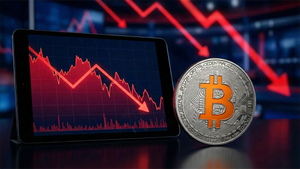
Gold, the perennial safe-haven asset, is currently experiencing a historic rally, with its price firmly set on a trajectory towards the $3,800 per ounce mark. This unprecedented surge, unfolding against a backdrop of persistent US inflation and the Federal Reserve's pivot towards interest rate cuts, is reshaping financial market expectations and influencing investment strategies globally. As of September 26, 2025, the precious metal is not just reflecting market anxieties but actively signaling a significant shift in the global economic landscape.
The immediate implications of this gold surge are profound. Investors are increasingly flocking to gold as a hedge against currency debasement and economic uncertainty, driving robust demand from both institutional and retail segments. The rally underscores a growing skepticism about the long-term stability of fiat currencies, particularly the US dollar, and highlights gold's enduring appeal as a store of value in turbulent times. This movement is not merely speculative; it is rooted in fundamental economic shifts and a re-evaluation of risk by major financial players.
The Unfolding Gold Rush: Inflation, Rate Cuts, and Geopolitical Undercurrents
Gold's journey towards $3,800 has been marked by a series of pivotal events and reactions. Spot gold has consistently traded above $3,750 per ounce, reaching an all-time record of $3,791 per ounce on September 23, 2025. This remarkable ascent represents an 11.25% increase over the past month and an astounding 42.20% gain year-over-year.
The rally gained significant momentum throughout 2025, breaking past the $3,500 threshold earlier in the year. A key moment occurred on September 18, 2025, when the Federal Reserve implemented its first interest rate cut of the year. Gold initially surged to a new high of $3,707.40 per ounce immediately after the announcement. However, a less dovish-than-expected outlook from Fed Chair Jerome Powell led to a swift, albeit temporary, pullback of nearly $50. The broader bullish trend quickly reasserted itself, culminating in the new historic peak just days later.
The persistent upward pressure on US inflation, particularly the Personal Consumption Expenditures (PCE) price index, has been a critical catalyst. The core PCE index, excluding volatile food and energy components, reported a 2.9% year-over-year increase in August 2025. This marks the 19th consecutive month that core PCE inflation has remained above the Fed's 2% target, firmly entrenching gold's role as an inflation hedge. Historical data shows gold performing exceptionally well when US inflation exceeds 3%, delivering average annual returns of 14.9% during such periods.
The Federal Reserve (Fed) itself is a central player in this drama. On September 17, 2025, the Fed cut the federal funds rate by 25 basis points to a target range of 4.00%-4.25%. This "risk-management cut," as described by Chair Powell, was in response to a weakening labor market. Crucially, the Fed's latest Summary of Economic Projections (the "dot plot"), released in September 2025, indicated that Federal Open Market Committee (FOMC) members anticipate two additional 25-basis-point rate cuts before the end of 2025, likely in October and December. These projections, coupled with elevated PCE inflation forecasts (3% for PCE and 3.1% for core PCE in 2025), signal an environment of negative real interest rates, a highly favorable condition for gold.
Beyond monetary policy, global central banks have emerged as formidable drivers of gold demand. Over the past three years (2022-2024), central banks engaged in an unprecedented gold-buying spree, acquiring over 1,000 metric tons annually, a trend that continued into 2025. This vigorous accumulation, particularly by emerging market central banks like the People's Bank of China and the National Bank of Poland, is motivated by a desire to diversify reserves away from the US dollar, hedge against geopolitical risks, and protect against inflation. In a historic shift, central banks now hold a larger share of their reserves in gold than in US Treasuries for the first time in decades. Geopolitical tensions, including the ongoing Ukraine conflict, trade disputes, and broader global instability, further reinforce gold's safe-haven appeal, contributing to the "fear premium" embedded in its price.
Corporate Fortunes in a Golden Era: Winners and Losers
The robust rally in gold prices towards $3,800 is creating a clear divide among public companies, presenting significant opportunities for some while posing considerable challenges for others.
Companies Positioned to Win:
Gold mining companies are among the most direct beneficiaries. With gold prices soaring and production costs remaining relatively stable, their profit margins are expanding substantially. Major producers like Barrick Gold (NYSE: GOLD) and Newmont (NYSE: NEM) are seeing significantly enhanced profitability, leading to stronger free cash flow. This allows them to invest more in exploration and development, reduce debt, and increase shareholder returns through dividends and share buybacks. For instance, Newmont (NYSE: NEM) and Barrick Gold (NYSE: GOLD) saw surges of approximately 27% and 21.5% year-to-date, respectively, as of March 2025. Smaller players such as Galiano Gold Inc. (NYSE-American: GAU), i-80 Gold Corp. (NYSE-American: IAUX), New Gold Inc. (NYSE-American: NGD), and Integra Resources Corp. (NYSE-American: ITRG) are also well-positioned to capitalize on the rally through strong operational cash flows. Investment vehicles like gold-focused Exchange Traded Funds (ETFs) such as SPDR Gold Shares (NYSE Arca: GLD) and VanEck Gold Miners ETF are experiencing heightened investor interest and increased assets under management (AUM), leading to appreciation in their share prices.
Companies Facing Challenges:
Industries that rely on gold as a raw material are facing significant headwinds. Jewelry manufacturers and retailers, for example, are directly impacted by the rising cost of their primary input. Companies like Tiffany & Co. (NYSE: TIF) or other major jewelry chains may see squeezed profit margins if they cannot fully pass on increased costs to consumers, potentially leading to reduced demand, especially in price-sensitive markets. Operational strategies may involve repricing inventory, shifting towards lighter-weight designs, or exploring alternative materials.
Similarly, high-tech sectors that use gold for its unique properties in electronics, nanotechnology, and advanced manufacturing (e.g., for connectors, circuit boards, medical diagnostics) face increased input costs. Companies in these sectors, if heavily reliant on gold and unable to substitute it without compromising performance, could see squeezed profit margins and potential negative impacts on their stock performance. These industries are likely to intensify efforts in cost-efficiency, innovation in gold usage, and gold recycling from electronic waste to mitigate the impact.
Broader Implications: A Shifting Global Financial Order
Gold's march towards $3,800 is not an isolated event but a symptom of profound shifts in the global financial order, with wider implications for commodities, currencies, and central bank policies.
The rally strongly reaffirms gold's traditional roles as a safe haven and an inflation hedge. Persistent geopolitical tensions, including conflicts in Eastern Europe and the Middle East, along with U.S.-China trade frictions, have amplified gold's appeal as a crisis-resistant asset. The stubbornly high US core PCE inflation, standing at 2.9% year-over-year, further cements gold's value proposition against eroding fiat currency purchasing power.
Perhaps the most significant structural trend underpinning gold's ascent is de-dollarization. Global central banks are strategically diversifying their reserves away from the US dollar, with gold accumulation reaching unprecedented levels. The share of dollar assets in central bank reserves has declined from approximately 75% in 1999 to 47% by late 2025. This trend, driven by a desire for financial stability and independence from a weaponized US dollar, provides a fortified floor for gold prices and signals a long-term recalibration of global monetary reserves.
The ripple effects extend to other commodities and currency markets. Gold's strength has buoyed other precious metals, with silver nearing a 14-year high due to its dual monetary and industrial appeal. Platinum and palladium have also seen uptrends. This synchronized strength across precious metals suggests a macro environment fundamentally favorable to real assets. In currency markets, a weakening US dollar, which has seen a 10.7% decline in the first half of 2025, makes dollar-denominated gold more affordable for international buyers, further boosting demand. A strong gold price often signals a weaker outlook for fiat currencies, influencing foreign exchange strategies and the perceived stability of national economies.
The Federal Reserve's policy actions carry significant regulatory and policy implications. The current rate-cutting cycle reduces the opportunity cost of holding non-yielding gold, making it more attractive. The Fed's willingness to cut rates amidst persistent inflation suggests a prioritization of labor market conditions, potentially leading to negative real interest rates—a historically bullish scenario for gold. However, any unexpected hawkish signals or a faster moderation of inflation could trigger temporary pullbacks.
Historically, gold has consistently performed well during periods of high inflation, as seen in the 1970s, and during Fed rate-cutting cycles. The first rate cut in an easing cycle typically triggers significant gold price appreciation, with gold gaining an average of 1.6% on the day of a cut and showing overwhelmingly positive returns (more than 7.7% on average) in the 6-12 months following. The current environment strongly aligns with these historical precedents, reinforcing the bullish outlook for the metal.
What Comes Next: Navigating the Golden Future
The trajectory of gold towards $3,800 is indicative of a market bracing for continued economic shifts. Both short-term and long-term possibilities point towards sustained strength, but investors and industries must remain agile.
In the short-term (late 2025 - early 2026), gold prices are expected to remain firm, potentially pushing towards the $4,000 mark. The anticipated additional Fed rate cuts in October and December, coupled with persistent core PCE inflation (projected to reach 3.0% by end-Q3 2025), will continue to create a favorable environment of negative real interest rates. Strong central bank demand, ongoing geopolitical tensions, and a weaker US dollar will also provide consistent tailwinds.
Looking long-term (2026-2030 and beyond), the outlook remains predominantly bullish. Institutions like J.P. Morgan, Goldman Sachs, and UBS project gold reaching $4,000 by mid-2026, with some forecasts extending to $5,000 by 2026 and even higher, potentially touching $11,330 by 2030. The structural shift in central bank behavior, moving away from dollar-centric reserves, is a significant long-term factor, as is gold's role as an optimal hedge against stagflation, recession, and currency debasement.
Strategic pivots are crucial for investors. Gold's strengthening role as a safe-haven and inflation hedge makes it a cornerstone of diversified portfolios. A "buy the dip" strategy could prove effective during any short-term corrections. Investors should also closely monitor real yields and continue to consider gold-backed ETFs for exposure. For industries, the mining sector will likely see increased investment in exploration and development, benefiting related equipment and service providers. The jewelry industry may need to adapt to higher input costs by focusing on higher-value pieces or exploring alternative materials and recycling.
Emerging markets present both opportunities and challenges. They are at the forefront of central bank gold accumulation, seeking to enhance financial sovereignty. These markets are also projected to account for over 40% of global gold mineral demand growth by 2025, driven by untapped reserves. However, price sensitivity in jewelry demand and political/regulatory instability remain challenges.
Several potential scenarios could unfold:
- Sustained Bull Run (Most Probable): The Fed continues with anticipated rate cuts, and core PCE inflation remains elevated. This environment, combined with geopolitical tensions and central bank buying, propels gold beyond $4,000/oz in 2026 and towards $5,000/oz.
- Moderate Gains with Consolidation: Rate cuts proceed, but inflation gradually moderates. Gold prices consolidate at high levels, experiencing volatility but maintaining a general upward trend at a more measured pace, supported by safe-haven demand.
- Corrective Pullback (Less Probable): An unexpectedly robust US economy and rapid disinflation lead the Fed to pause or reverse rate cuts. Geopolitical tensions ease, reducing safe-haven demand. While less likely, this could see a correction, though strong structural demand would likely limit significant downside.
Comprehensive Wrap-up: A New Golden Age?
The current gold rally towards $3,800 is a multifaceted event, driven by a confluence of persistent US inflation, a dovish Federal Reserve, and a significant shift in global monetary policy towards de-dollarization. The key takeaways are clear: gold's role as a safe-haven asset and inflation hedge has been unequivocally reaffirmed, central bank demand is a powerful structural force, and the environment of negative real interest rates is a potent catalyst.
Moving forward, the market is poised for continued strength in gold. The Fed's current rate-cutting cycle, coupled with sticky inflation, creates a compelling case for gold's sustained appeal. While short-term volatility is always possible, the underlying drivers suggest a robust bullish environment for the precious metal.
Investors should watch closely for further signals from the Federal Reserve regarding the pace and extent of future rate cuts. Any unexpected shifts in inflation data, particularly core PCE, will also be critical. Geopolitical developments and the ongoing trends in central bank gold accumulation will continue to exert significant influence. For those seeking to preserve wealth and diversify portfolios in an uncertain economic climate, gold's current trajectory signals its enduring significance and potential for lasting impact.
This content is intended for informational purposes only and is not financial advice





